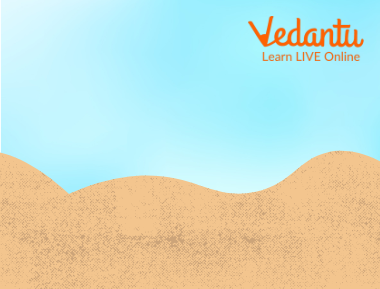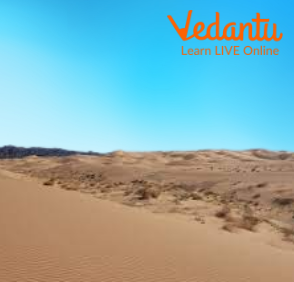




Why Are Deserts Important? Climate, Wildlife & Amazing Adaptations
Most people envision a desert as a sand-covered, hot, and dry region. However, there are also additional desert types. Any sizable area that receives relatively little rain annually is considered a desert. Desert regions support very few plant or animal species. There are several different definitions to describe a desert, but they are typically areas that receive extremely low amounts of rain. In a year, deserts generally receive less than 16in of rain. Deserts can be hot or freezing cold. In scorching deserts, summertime midday temperatures are frequently exceeding 100 °F (38 °C). Artic and Antarctic have cold deserts.

Desert
Features of Deserts
Deserts cover twenty percent of the territory on Earth. They are found on every continent. The land features of deserts vary widely. They could consist of mountains, bare rock, rocky plains, and moving dunes. Contrary to popular belief, dunes are not as common in deserts. For instance, they only account for 10% of the Sahara in northern Africa. Some deserts don't even have sand.
Different Types of Deserts
It can be hot or freezing in deserts. In scorching deserts, summertime midday temperatures are frequently exceeding 100 °F (38 °C). At night, the temperature lowers significantly. The Sahara is the biggest hot desert on earth. Other scorching deserts include those in the southwest of the United States and the Kalahari in southern Africa. The tropics are home to the majority of hot deserts. On either side of the equator is this strip of Earth.
Farther from the equator than hot deserts are cold deserts. Despite being extremely dry, the fact that it is so cold there is the main cause of the lack of plants there. Much of Antarctica is covered by a chilly dessert. An additional chilly desert is the Gobi in central Asia.

Gobi Desert
Interesting Facts about Desert
A total of one-third of the Earth's surface is deserted. Another meaning of the desert is abandoned land. Here are some amazing facts about deserts.
The Arctic and Antarctic are referred to as polar deserts.
20% of the total deserts have sand on their surfaces.
Cold deserts have a very low temperature in comparison to hot deserts and are covered with snow or ice.
The largest cold desert on Earth is Antarctica.
The largest hot desert on Earth is the Sahara.
Less than 40cm (16in) of rain falls on deserts on average each year.
One-third of the Earth's surface is barren land or desert land.
The word "desert" means an abandoned place.
Polar deserts are a term used to describe many of the ice-free areas of the Arctic and Antarctic.
Sand is only present in about 20% of the world's deserts.
When compared to "hot deserts" in hotter regions, locations covered with ice or snow are sometimes referred to as "cold deserts."
Antarctica is the world's biggest cold desert.
The Sahara is the world's biggest hot desert.
The Sahara Desert is in northern Africa and extends over 12 nations.
Although it is considerably smaller than the Sahara, the Arabian Desert in the Middle East is the second-largest hot desert on Earth.

Sahara Desert
Summary
Deserts are often found in regions with very little rainfall. Less than 40cm (16in) of rain falls on deserts on average each year. Deserts can experience extreme temperatures. A desert can be characterised in a variety of ways, but generally speaking, it refers to regions with very little rainfall.
Sand is only present in about 20% of the world's deserts. In contrast to "hot deserts" in warmer regions, regions covered in ice or snow are also referred to as "cold deserts."
FAQs on The Desert: Fascinating Facts Every Student Should Know
1. What exactly is a desert and what makes a place a desert?
A desert is a large, dry region that receives very little rainfall, usually less than 25 cm per year. The main factor that defines a desert is this lack of precipitation, not its temperature. This is why deserts can be either very hot, like the Sahara, or very cold, like the Antarctic Polar Desert.
2. Can you give some examples of major deserts around the world?
Certainly. Deserts are found on every continent. Some of the most well-known examples include:
- The Sahara Desert in North Africa, which is the world's largest hot desert.
- The Gobi Desert in China and Mongolia.
- The Kalahari Desert in Southern Africa.
- The Great Victoria Desert in Australia.
- The Antarctic Polar Desert, which is the largest desert of any kind on Earth.
3. What kind of animals and plants can be found in such a dry environment?
Deserts are home to unique life that has adapted to the tough conditions. Common examples are:
- Plants: Cacti, date palms, and hardy shrubs that are excellent at storing water.
- Animals: Camels, lizards, snakes, scorpions, and small rodents. Many of these animals are nocturnal, meaning they are active at night to avoid the intense daytime heat.
4. How do desert plants like cacti manage to survive with so little water?
Plants in the desert have special features for survival. A cactus, for instance, has a thick, waxy skin to prevent water from escaping and long, shallow roots to quickly soak up any rain that falls. Its spines are actually a type of leaf that helps protect it from animals and reduces water loss.
5. Why is Antarctica considered a desert if it's completely covered in ice and snow?
That's an excellent question that highlights a common misunderstanding. A place is classified as a desert based on its low amount of precipitation (rain or snow), not its temperature. Antarctica receives very little new snowfall each year, making it the world's largest cold desert. The vast ice sheets are the result of thousands of years of accumulated snow that never melts.
6. Why do hot deserts often become very cold at night?
Hot deserts cool down so quickly at night because the air is extremely dry. Unlike in humid places, there are very few clouds or water vapour in the air to trap the heat from the day. Once the sun sets, all the heat absorbed by the sand radiates back into the atmosphere, causing a sharp drop in temperature.
7. Is it possible for people to live in deserts?
Yes, people do live in deserts, often in communities settled around an oasis, which is a fertile area where water from an underground spring is available. Additionally, some cultures, like the Bedouins in the Arabian Desert, are nomadic, meaning they move with their herds to find grazing land and water sources.





















